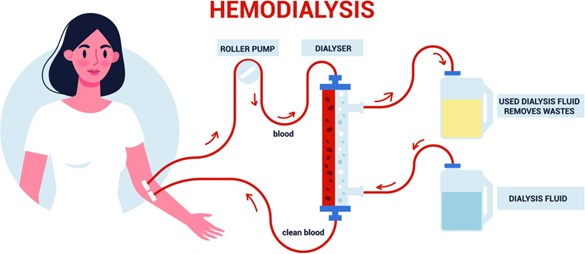A client reports that she ingested 1/2 of a liter of a prep solution for a colonoscopy. How many mL of fluid intake should the practical nurse (PN) document?
(Enter numeric value only. If rounding is required, round to the nearest whole number.)
The Correct Answer is ["500"]
1 liter is equal to 1000 milliliters. Therefore, to calculate the fluid intake in mL, we can multiply 1/2 liter by 1000 mL/liter:
1/2 liter * 1000 mL/liter = 500 mL
So, the practical nurse should document 500 mL as the client's fluid intake.
Nursing Test Bank
Naxlex Comprehensive Predictor Exams
Related Questions
Correct Answer is ["591.4"]
Explanation
To calculate the total intake in milliliters (mL), we need to convert the given measurements from ounces to milliliters and then sum them up.
1 ounce (oz) is approximately equal to 29.57 milliliters (mL).
Given intake: 4 ounces apple juice = 4 oz * 29.57 mL/oz = 118.28 mL 8 ounces milk = 8 oz *
29.57 mL/oz = 236.56 mL 4 ounces broth = 4 oz * 29.57 mL/oz = 118.28 mL 4 ounces tea = 4 oz
* 29.57 mL/oz = 118.28 mL
Total intake = 118.28 mL + 236.56 mL + 118.28 mL + 118.28 mL = 591.4 mL
Correct Answer is D
Explanation
Hemodialysis is a procedure used to remove waste products and excess fluid from the blood when the kidneys are unable to function properly. One of the waste products that accumulate in the blood during kidney dysfunction is creatinine. Creatinine is a byproduct of muscle metabolism, and its levels in the blood are normally regulated and eliminated by the kidneys. In AKI, the kidneys are not able to effectively filter and eliminate creatinine, leading to elevated levels in the blood. Hemodialysis helps to remove excess creatinine from the blood, resulting in decreased creatinine levels.

A- Elevated potassium levels (hyperkalemia) are common in AKI and can be life-threatening. Hemodialysis helps to remove excess potassium from the blood, restoring normal levels.
However, the best indicator of the effectiveness of hemodialysis in managing hyperkalemia would be monitoring the potassium levels before and after the session rather than considering it as the "best" indicator.
B- Decreased calcium levels can occur in kidney dysfunction due to impaired activation of vitamin D and decreased absorption of calcium from the intestines. While hemodialysis can help restore calcium levels, it may not be the primary laboratory value used to evaluate the effectiveness of each session.
C- Lowered hemoglobin levels can be seen in AKI due to various factors, including decreased production of red blood cells and blood loss. Hemodialysis can help remove waste products and excess fluid, but it may not directly address the underlying causes of lowered hemoglobin levels.
Whether you are a student looking to ace your exams or a practicing nurse seeking to enhance your expertise , our nursing education contents will empower you with the confidence and competence to make a difference in the lives of patients and become a respected leader in the healthcare field.
Visit Naxlex, invest in your future and unlock endless possibilities with our unparalleled nursing education contents today
Report Wrong Answer on the Current Question
Do you disagree with the answer? If yes, what is your expected answer? Explain.
Kindly be descriptive with the issue you are facing.
